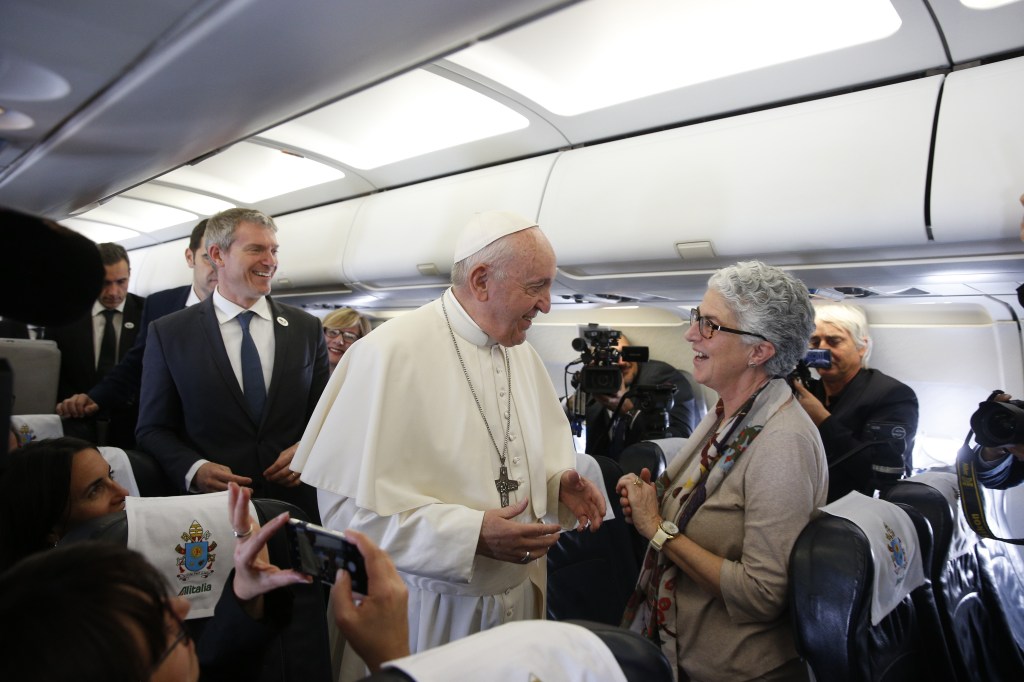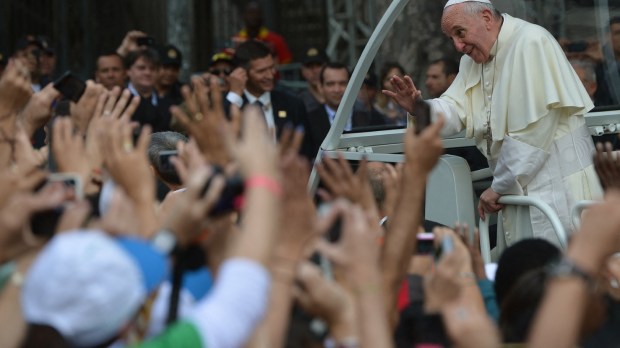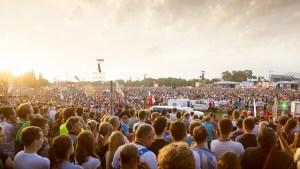From Spain to the Philippines to the US, Aura Miguel has attended and reported on every World Youth Day (WYD) since 1989. A veteran journalist covering the Vatican and the Church for Portuguese radio station Radio Renascença, she is an expert on this gathering of Catholic youth, which attracts around 1 million people. As the next WYD will be held in her hometown, Lisbon, in early August, she published a book on the past editions called “Um Longo Caminho até Lisboa: Jornadas Mundiais da Juventude” (A Long Way to Lisbon: World Youth Day).
The book includes a preface written by Pope Francis and for now is only available in Portuguese. Miguel spoke with Aleteia about what makes this event special for everyone who participates and what her expectations are for the Lisbon WYD.

What do you think is special or unique about this year’s WYD in Lisbon?
Miguel: This is a mystery; every WYD is different and it is beautiful to see. The context always changes. For example, in the WYD in Santiago de Compostela (Spain) in 1989, Europe was still a divided continent. In the following one in Częstochowa (Poland) in 1991, the Berlin Wall had fallen, so for the first time there were young Catholics from Russia. Another example is when John Paul II went to the WYD in Toronto in 2002, not long after the September 11 attacks. There are always controversies and protests before a pope arrives but the end result is spectacular. WYD is such a grandiose event, it is rare and unique, people do not realize how big it is until they witness it.
Lisbon is very beautiful. It is next to a river and turned towards the ocean. There is Africa on one side and the Americas on the other. These are the horizons that the Pope asks us to enlarge. I am sure that whatever the Pope is going to bring to this WYD will be of great help to young people so that they can live their faith in a contemporary manner, with all the challenges that they face today.
What do you think is the most important part of WYD for young people?
Miguel: The most important dimension in my opinion is the personal experience of each person. It is those encounters that tear the horizons. The young Catholics have been on a journey to prepare themselves to get to that destination and they know why they are there.
Due to secularization, being a Catholic today is almost like going against the tide. This has been the case since 2000 but it has become even more evident today. I remember interviewing a young man in Rome during the 2000 WYD and he told me: “Suddenly I look around and I see 1 million people like me, who go to confession, who attend church on Sundays, and are not aliens like those at the school I go to want to make me believe.”
This is the awareness that emerges, it is a multifaceted population. Everyone is really different, they come from all over the world. However, at the same time they are united in this amazing experience because of the pope.
What do you think will be the Pope’s message to young Catholics?
Miguel: Pope Francis wrote the preface to my book and it is the most wonderful thing about it! When I saw him on one of the papal trips I asked if he could write a few words for my book on WYD. He instead sent four pages for a preface! I hope the themes he speaks about in these pages are what he will develop in Lisbon.
He said that today we are in a change of epoch. Our society is increasingly less Christian in its expression, meaning there are new challenges for new generations. The youth are so-called “digital natives,” he explains, and so they are at daily risk of isolating themselves. I think one of the objectives of this WYD is to encourage young people to not “balcony,” meaning not to stand on the balcony watching things go by but embrace reality to discover what is worth living for.
I think Pope Francis in this preface suggests an attitude he will propose during WYD. He cites an Italian priest, Father Lorenzo Milani, who says “I care, I am interested, I take care of.” After the COVID-19 pandemic, which isolated everyone, the attitude of thinking we can only save ourselves together is important. Young people are called to look around them completely, and in that reality meet Christ. Even in the digital landscape that we live in we are called to make it more human.
The Pope says “the World Youth Days have been an antidote to the ‘balcony,’ to the anesthesia that makes one prefer the couch, the indifference.” The Pope wants to shake young people through WYD so that they can enlarge their horizons. I hope this happens in Lisbon!
Why do you think the Pope calls young people to come together?
Miguel: The main objective is to reinforce and revive the encounter with Christ. That encounter is deeply personal and our Lord is very discreet at times. He silently does miracles in each person’s heart and we often do not even see it. I have a goddaughter who was a jazz singer and schoolteacher. Today, thanks to her experience at the Madrid WYD in 2011, she is a happy cloistered nun.
There are many examples like this. Many young people go because it is fun and they want to be with young Catholics who think like them. But then they suddenly open their hearts to the proposal the pope brings. This is the most fascinating part about WYD and I think Lisbon will be the same.
Why did you decide to write a book about WYD?
Miguel: For every papal trip I have been on, I have a folder with all the materials I gather so I have a large archive featuring more than 100 journeys. This archive includes the 13 WYD I have gone to. WYD has been on all continents, it is full of color, life, and unexpected events.
There are many generations that have now attended WYD since John Paul II started this adventure 40 years ago in 1983. I decided to write this book as a manual for this event. Every chapter is autonomous and dedicated to one edition. I met some older people who told me, “I remember that WYD you wrote about, I was there.” Instead, younger people who may not have gone to any WYDs and are curious about it can also read the book. It is for anyone who wants to know more about the richness of these gatherings.
I also wanted people to realize how different things were before. There were no mobile phones at the beginning. To call Lisbon from Poland you had to wait for an hour at the post office. It was a different reality and context. So each chapter has a section dedicated to what was happening in the world, in the Church and in Portugal at the time. Then there is another section called “Best of” where I give a summary of the best parts of what the pope said in his speeches. There is also a section with my experience as a journalist including the people I met and the fun things that happened.
Can you share an anecdote?
Miguel: In Santiago de Compostela in 1989 the toilets were terrible because they were portable and the water was rationed. In addition, it had rained, so everything was slippery and full of mud. There were some of my friends who knew I was in a hotel so they organized a covert plan to try and secretly use my bathroom to shower. Other than meeting with bishops and Church members there are also these funny moments.
Another anecdote I write about is that I met Pope Francis for the first time on the plane going to the WYD in Rio de Janeiro (Brazil) in 2013. All the journalists introduced themselves. I told him that I was happy to join him on this trip and that I had covered all the WYD up until then, except the first one in Buenos Aires (Argentina) in 1983. He replied that the one in Buenos Aires, his hometown, was the only one he had attended.
How are Catholics in Portugal getting ready for this event? What is the atmosphere like?
Miguel: Everything is still at the diocesan level for now. The WYD icons have been traveling across the dioceses. There is a lot of preparation from the volunteers as well, there are thousands who have already signed up and will be available to help.
There are also more than 600,000 people who have registered to attend now but I think the number will continue to increase as the date approaches. My experience has been that when the WYD events actually begin, the young people who were still hesitant start to join. We Portuguese love the beach and August is exactly the time of year where everyone leaves the city for the seaside. Many young people may be hesitating as they do not want to give up their holidays. However, when they realize this is worth it, I think they will join.
In parishes, adults have also been encouraged to open up their homes and welcome the young people. The Pope has also sent a message acknowledging that letting people in your home and giving up your holiday can cause some discomfort but highlighting that it is a richness. This is a great experience and I have seen it in previous editions. It is a way for adults to participate in the WYD.


